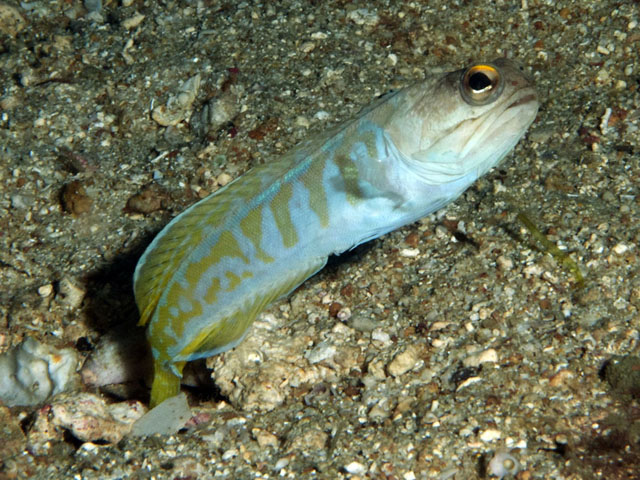| Opistognathidae (Jawfishes) |
| 10.43 cm SL (male/unsexed); 10.85 cm SL (female) |
|
pelagic-neritic; marine; depth range 5 - 32 m |
| Western Pacific: Indonesia, eastern Borneo and the Philippines. |
|
Dorsal spines (total): 11-11; Dorsal soft rays (total): 14-16; Anal spines: 3-3; Anal soft rays: 14-15; Vertebrae: 28-28. This species is distinguished by the following characters: elongate supramaxilla and posterior end of maxilla produced as a thin flexible lamina; a single conspicuous black stripe at inner lining of upper jaw and adjacent membranes; dorsal, anal and caudal fins with narrow, pale (blue in life) distal margins; when alive, dorsal portion of iris golden; lateral-line terminus below verticals between segmented dorsal-fin rays 1 to 4, typically below second to third ray; caudal vertebrae 18 (Ref. 81517). |
| Males of this species are strongly territorial and frequently engage in jaw locking combat, apparently to evict rivals or confiscate their burrows (Ref. 81517). Found in sand/rubble bottoms near reefs in about 5-30 m (Ref 90102). |
|
Not Evaluated (N.E.) Ref. (130435)
|
| harmless |
|
Type locality, Palawan Province, Cocoro Island, ANSP 142963 (holotype of Opistognathus randalli, 8.72 cm SL, gravid female)>. Also collected from Negros oriental (off Bonbonon Point, Apo I.), Mindoro (Puerto Galera), Batangas (Caban I., Sumilon I.), Cebu (Siquijor), and Mindanao (Murcielagos Bay) (Ref. 81517). Also Ref. 90102. |
Source and more info: www.fishbase.org. For personal, classroom, and other internal use only. Not for publication.

